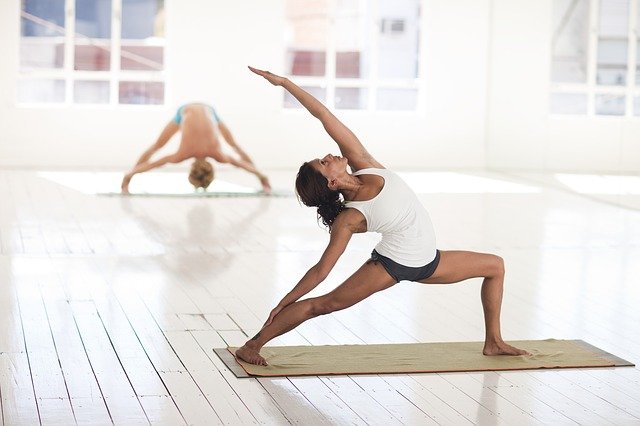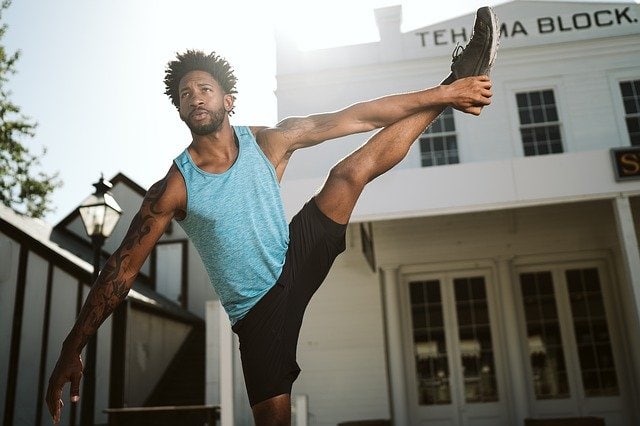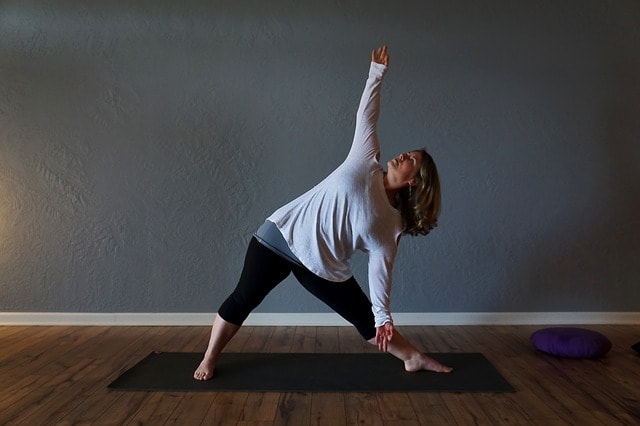Whether we’re working from home or back in the workplace, we’re probably spending a large part of our day in one position. Do you wake up with a stiff back? With aching knees? With a crick in your neck? Research has shown that more than 70% of Australian adults are classified as sedentary. These exercises for flexibility will help reduce the damage that a sedentary lifestyle is causing you.

What happens if I exercise for flexibility?
Being seated for many hours of a day causes major health concerns but also leads to tight and inflexible muscles. When your muscles lose their flexibility and become rigid, you’re more likely to be injured.
If you work on your flexibility, you can loosen up those tight and stiff muscles in order to reduce pain and pent-up muscular tension. Besides the physical benefits, stretches for flexibility also tend to provide mental relief by allowing you to take breaks from the continuous sitting that has become inevitable in most of our lives.
Another benefit of doing stretches for flexibility now is that you will remain limber and supple well into your senior years. As you get older, bone density and joint mobility reduces, causing stiff joints and body ache. If you have been working out for most of your life, you are less vulnerable to physical problems as well as mental conditions. Research has shown that there are tremendous benefits to working out as you get older.
What does it mean to exercise for flexibility?
Exercising for flexibility means following a dedicated regimen that is focused on improving your flexibility and muscle strength. When your muscles are relaxed and stretchy, you are less prone to injuries like muscle tears or sprains and you will notice that those niggling aches and pains are not so frequent.

Doing stretches for flexibility extends your muscle groups for a specific duration of time. These stretches forces your muscles, joints, ligaments and tendons into lengthening and expanding. The movement encourages your body to become comfortable with that feeling and as you increase the duration and intensity of the stretch, your body becomes more flexible.
What are the different kinds of stretches for flexibility?
All stretches for flexibility can be classified into three primary types which are:
Static stretching
Regarded as the safest method of stretching, static stretching involves moving your muscles to the limit and holding it there as long as 30-40 seconds without pain. You do not move your limb or muscle during this stretch. For example: After a marathon, you may see a runner pulling their foot back and holding it behind their back to stretch their thigh muscles. This kind of stretching is good for cooling down after an activity.

Dynamic/ballistic stretching
Dynamic stretches involve pushing the joint through its entire range of motion. These type of stretches are best to prepare muscles and joints for high-level exercises but do not offer much benefits by way of improving flexibility. You move the limb or muscle repeatedly to warm it up and prepare it for activity. For example, you may see a boxer preparing for his or her match by twisting from left to right, moving their torso and swinging their arms.
Proprioceptive neuromuscular facilitation (PNF) stretching
PNF consists of a cycle of stretching that follows a specific formula. You’ll stretch, contract, relax and stretch again to make sure the muscle gets the maximum workout. This type of stretch gives you the best range of motion and considerably improves your flexibility. For example, you might see a medic or physiotherapist on the football field treating an injured player by moving his or her leg up and down slowly.
How do I get started with exercise for flexibility?
You can begin a flexibility routine by doing a targeted workout two to three times a week. If you work out regularly, you should be stretching before and after your session anyway. If you don’t do this, do consider adding some stretches to your routine in order to assist with muscle recovery and prevent any strain to your joints. Consider the following routine to limber up:
- Stretch only warm muscles i.e. after exercise or warming up
- Repeat the stretch a minimum of two to three times, working both sides of the body
- Hold stretches for 10 to a maximum of 30 seconds.
- Stretch till you feel tension, not pain
- Breathe deeply while you stretch

What improvements can I expect with exercise for flexibility and movement?
Stretches for flexibility encourage the lengthening of your muscles and the tendons. This offsets the tightening of your muscles that happens with age and inactivity. For the increasingly sedentary lifestyles we lead, we are at risk for a number of muscular and physical conditions as we get older, so stretching can ward off a number of complaints before they begin.
When you work on lengthening your muscles, you will enjoy improved flexibility and a greater range of motion. This allows you to stay healthy and active so you can perform the activities that are basic to your daily needs.
If you exercise for flexibility, you will also notice a calmer lighter feeling in your body and mood after a workout. Stiff muscles can make you feel anxious and tightly wound, whereas stretching will unblock circulation, boost oxygen in your blood, and leave you feeling alert and fit.

How can I gauge my current level of flexibility?
There are plenty of tests to help determine your level of flexibility. These tests are usually done as part of initial assessment by fitness professionals to help them better understand your current level of fitness and ability. It allows them to come up with an exercise plan that is best suited to your needs so that you can gain maximum flexibility benefits. The three most common tests done are the hip flexor test, the shoulder flexion test, and the supine hamstring test.
For a greater understanding of these tests in specific or your flexibility in general, it is always recommended to get in touch with any of the following professionals to address your specific needs and ensure that you gain the maximum health benefits. Ensure that the professionals you approach are registered or accredited and ideally referred to by family, friends or your medical practitioner.
- Physiotherapist
- Sports doctor
- Fitness trainer
- Health coach
When is the best time to exercise for flexibility and mobility?
The golden rule when doing any exercise for flexibility is to stretch muscles only when they are warm. Warm muscles, which have more blood flowing through them are loose enough to not only benefit from the stretches but also prevent any risk of injury. Bearing that in mind, you can considering stretches for flexibility during the following times:
- After a workout to cool down, reduce muscle soreness and get rid of any toxins that have accumulated
- While you watch your favorite shows to help your body unwind and release tension
- At work when you want to take a break and stretch your limbs

Is there a routine of exercise for flexibility and mobility?
You do not always have to depend on independent stretches in order to improve flexibility. There are a few sports or fitness practices that teach exercise for flexibility. The three principal ones are:
Pilates
Pilates is a slow and controlled form of exercise, carried out either on a mat or through special Pilates equipment. It stretches and strengthens the muscles and tendons to improve balance, posture and flexibility with primary focus on the core of your body.
Yoga
It might have evolved as a spiritual practice but it has a number of postures (asanas) that are not only great stretches for flexibility but also allow you to develop muscle strength. Like Pilates, the focus is on the core of your body with gentle movements that help relieve tension.
These easy in-bed yoga moves will ease a bad back
Tai Chi
What originated in China as a form of martial art has evolved into a gentle form of exercise. It involves slow movements that flow into each other allowing the body to be in motion but at a gentle pace. Through this it improves balance, flexibility and posture.
What precautions should I take when I exercise for flexibility?
Do not confuse stretching with warming up. If you stretch cold muscles, you could hurt yourself. A warm-up is meant to get blood flowing to your muscles so that you use them effectively and to ready the body for an increase in temperature.
Do exercise when you have time to do so. Hurrying through stretches may cause injury or more pain.
Wear comfortable clothes that do not restrict your movement.
Drink water before, during and after your workout. When you are dehydrated, your muscles will be dry and prone to stiffness and injury too.
If you have any pre-existing medical conditions, have recently had surgery, or have chronic pain, do consult your doctor before starting any regime.

If you’re wondering Where can I do yoga near me, Avaana has you covered.



